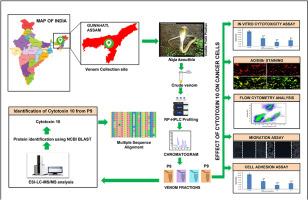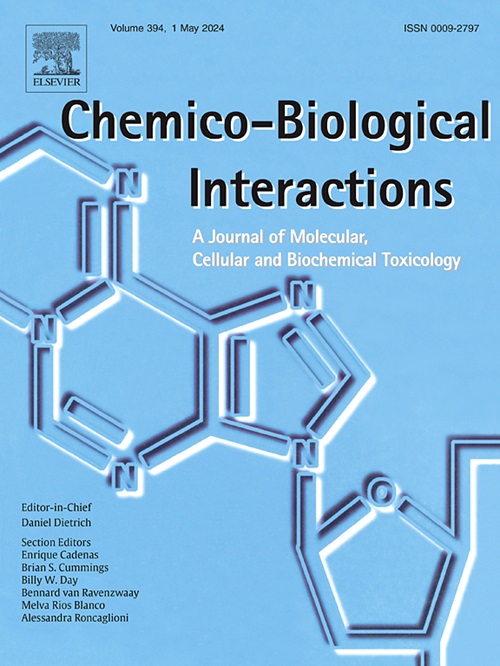Exploring the anticancer potential of Cytotoxin 10 from Naja kaouthia venom: Mechanistic insights from breast and lung cancer cell lines
IF 4.7
2区 医学
Q1 BIOCHEMISTRY & MOLECULAR BIOLOGY
引用次数: 0
Abstract
Breast and lung cancers are the leading causes of cancer-related deaths in the world. Although considerable progress has been made in the field of cancer therapy, quest to discover potent, safe and cost-effective alternatives especially from natural sources is being pursued. Snake venom, which is a treasure trove of various peptides and proteins including natural toxins that specifically target tissues and receptors in the envenomated victims. Many such proteins are being explored for their therapeutic potential against various diseases including cancers. Here, we report the mechanism of cytotoxic activity of crude venom and a purified protein, Cytotoxin from the monocled cobra (Naja kaouthia), an elapid snake with neurotoxic venom prominently found in the North-East India. The crude venom showed significant cytotoxicity against breast (MCF-7and MDA-MB-231) and lung (A549, NCI–H522) cancer cell lines. Bioassay-guided fractionation using RP-HPLC showed highest cytotoxic activity in peak P9. Liquid chromatography-tandem mass spectrometry (ESI-LC-MS/MS) analysis was employed and the fraction is identified as Cytotoxin 10 which showed comparable cytotoxicity against the experimental cell lines. Cytotoxin 10 also exhibited apoptosis in MCF-7 and A549 cell lines using AO/EtBr and flow cytometry analysis. Expressions of apoptosis related proteins e.g. Bax, Bcl-2, Caspase-7 and PARP were also studied following Cytotoxin 10 treatment in both cell lines. Molecular docking experiments performed to investigate the interactions between Cytotoxin 10 and the apoptotic proteins revealed favourable binding scores compared to their corresponding inhibitors. Interestingly, Cytotoxin 10 inhibited migration and adhesion in a time and dose-dependent manner in both MCF-7 and A549 cells. This is the first report elucidating the mechanism of cytotoxic activity of Cytotoxin 10 purified from Naja kaouthia venom of North-East India origin and could pave the way for development of potential therapeutic strategies against breast and lung cancer.

探索Naja kaouthia毒液中细胞毒素10的抗癌潜力:乳腺癌和肺癌细胞系的机理研究
乳腺癌和肺癌是全球癌症致死的主要原因。尽管在癌症治疗领域已经取得了相当大的进展,但人们仍在努力寻找有效、安全和具有成本效益的替代疗法,特别是从天然来源中寻找替代疗法。蛇毒是各种肽和蛋白质的宝库,其中包括专门针对被毒蛇咬伤的组织和受体的天然毒素。目前正在探索许多此类蛋白质对包括癌症在内的各种疾病的治疗潜力。在这里,我们报告了单舌眼镜蛇(Naja kaouthia)粗毒和纯化蛋白细胞毒素的细胞毒活性机制。粗毒液对乳腺癌(MCF-7 和 MDA-MB-231)和肺癌(A549、NCI-H522)细胞株具有明显的细胞毒性。使用 RP-HPLC 进行生物测定指导分馏显示,P9 峰的细胞毒性活性最高。通过液相色谱-串联质谱(ESI-LC-MS/MS)分析,确定该馏分为细胞毒素 10,它对实验细胞株具有相当的细胞毒性。使用 AO/EtBr 和流式细胞仪分析,细胞毒素 10 还能使 MCF-7 和 A549 细胞株凋亡。此外,还研究了细胞毒素 10 处理两种细胞系后凋亡相关蛋白(如 Bax、Bcl-2、Caspase-7 和 PARP)的表达情况。为研究细胞毒素 10 与凋亡蛋白之间的相互作用而进行的分子对接实验显示,与相应的抑制剂相比,细胞毒素 10 与凋亡蛋白的结合得分较高。有趣的是,细胞毒素 10 对 MCF-7 和 A549 细胞的迁移和粘附有时间和剂量依赖性抑制作用。这是第一份阐明从印度东北部 Naja kaouthia 毒液中提纯的细胞毒素 10 的细胞毒性机制的报告,可为开发针对乳腺癌和肺癌的潜在治疗策略铺平道路。
本文章由计算机程序翻译,如有差异,请以英文原文为准。
求助全文
约1分钟内获得全文
求助全文
来源期刊
CiteScore
7.70
自引率
3.90%
发文量
410
审稿时长
36 days
期刊介绍:
Chemico-Biological Interactions publishes research reports and review articles that examine the molecular, cellular, and/or biochemical basis of toxicologically relevant outcomes. Special emphasis is placed on toxicological mechanisms associated with interactions between chemicals and biological systems. Outcomes may include all traditional endpoints caused by synthetic or naturally occurring chemicals, both in vivo and in vitro. Endpoints of interest include, but are not limited to carcinogenesis, mutagenesis, respiratory toxicology, neurotoxicology, reproductive and developmental toxicology, and immunotoxicology.

 求助内容:
求助内容: 应助结果提醒方式:
应助结果提醒方式:


